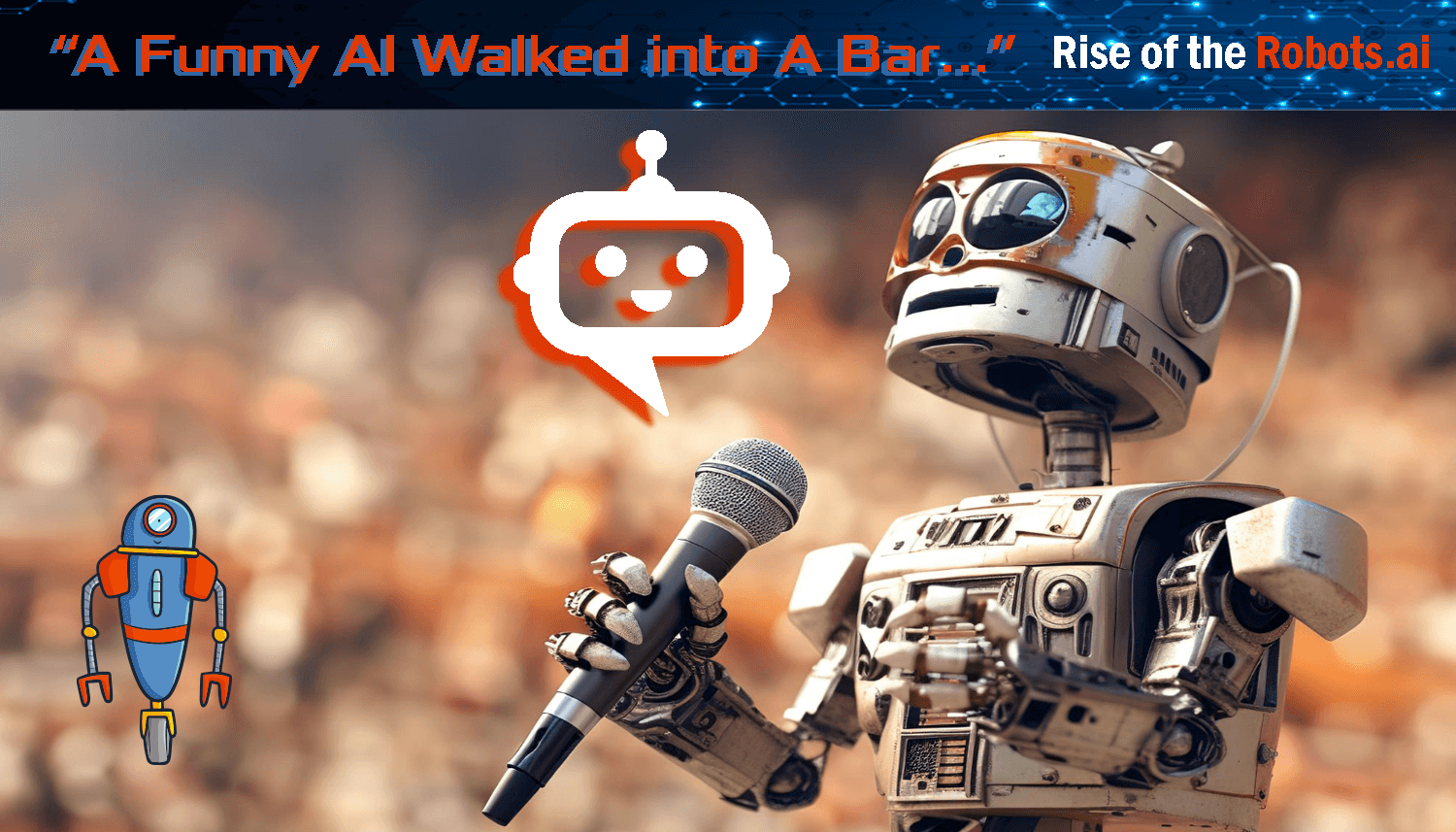Discover Pandipedia
Pandipedia is the world's first encyclopaedia of machine generated content approved by humans. You can contribute by simply searching and clicking/tapping on "Add To Pandipedia" in the answer you like. Learn More
Expand the world's knowledge as you search and help others. Go you!
Core Process Overview

AI humor models generate captions for images through a complex process that mimics human cognitive and creative skills[2]. This involves several key steps, often including visual detail extraction, humor ideation, narrative extrapolation, and caption ranking[2][3]. By integrating creative, social, and cognitive skills, AI-generated humor aims to produce communication that resonates with people[2].
Visual Detail Extraction
The initial stage involves a detailed analysis of the input image using visual language models (VLMs) such as GPT-4o[3]. This component extracts key visual elements, including objects, human expressions, and background settings[3]. The AI identifies the subject, main action, and background elements to build a foundation for humor[3]. For example, in an image of a demolition site, the system identifies a large industrial excavator and a person spraying the site with a hose[3].
Humor Ideation and Angle Selection
After extracting visual details, the system ideates on potential humorous elements[3]. This involves identifying funny facial expressions or analogous elements within the image[3]. The system analyzes the image and proposes humorous angles, considering both direct and indirect humorous aspects[3]. For instance, the visual contrast between an excavator and a person might be interpreted as a David versus Goliath scenario, providing a foundational metaphor for generating humorous captions[3].
Narrative and Conflict Extrapolation
To add depth and relatability, AI models often extrapolate narratives and conflicts that draw upon common and relatable experiences[3]. This step connects the visual elements with broader life experiences, making the humor more accessible[3]. The system chains together the results of the previous steps into a new prompt sent to GPT-4o[3]. The prompt contains the visual details, the visual humor ideation, and a list of common Gen Z experiences, and the instruction to 'generate narratives that reflect the essence of the image that is set within the framework of the Gen Z experience'[3]. These narratives are generated based on common experiences such as work, school, family, and relationships[3]. For example, a demolition site image might generate narratives like 'Tackling student loans' or 'Group Project Disaster,' which are common among Gen Z[3].
Caption Generation
In this stage, the system generates humorous captions using a fine-tuned language model[3]. A fine-tuned version of GPT-3.5 trained on humorous Instagram comments is often employed[3]. The captions are generated through two distinct strategies: focusing on the visual humor of the image and incorporating external narratives[3]. Image-focused captions comment directly on the image content, while narrative-driven captions introduce external references to add humor[3]. For example, an image-focused caption might be, "bro out here getting paid $8 an hour to spray some water on some bricks," while a narrative-driven caption could be, "The entitled bro you tried to make the group presentation with"[3]. Caption generation is segmented into two separate prompts utilizing the fine-tuned GPT-3.5 model[3].
Caption Ranking and Filtering
The generated captions are then ranked and filtered to select the most effective ones[3]. A GPT-4o-based agent, fine-tuned to evaluate humor from a Gen Z perspective, assesses the captions based on humor, relatability, and alignment with the image and narrative[3]. This agent filters out captions that do not meet the humor threshold, ensuring that only the most relevant and relatable captions are presented[3]. For example, captions like 'Me mopping up my last relationship' might be favored over less relatable ones[3].
Fine-Tuning and Training Data
Fine-tuning is crucial for tailoring the AI model to generate relevant and engaging humor[3]. This involves training the model on datasets of humorous comments and captions[3]. For example, a GPT-3.5 model can be fine-tuned using a dataset of humorous Instagram comments to better capture Gen Z humor[3]. The quality and quantity of the training data play a significant role in the performance of the model[1].
Specific AI Techniques
Several AI techniques are utilized in this process, including prompt engineering, fine-tuning, and chain-of-thought processing[2]. Prompt engineering involves crafting prompts that clearly define the problem and expected output[2]. Fine-tuning allows the model to learn specific patterns of a target output type[2]. Implicit in this is the tone, the style, and the vocabulary expected in the humor[2]. Chain-of-thought processing helps models by explicitly detailing the steps[2]. Chains are used to separate stages of the humor generation process[2]. An observation stage makes implicit information in images explicit, similar to the spirit of chain-of-thought and thought experiments[2].
Utilizing User Preferences & Cultural Nuance

AI models can analyze user preferences, interests, and even their sense of humor to generate tailored jokes[1]. One approach to achieving this personalization is by leveraging collaborative filtering techniques, which are commonly used in recommendation systems[1]. This involves identifying users with similar tastes and recommending jokes that have been enjoyed by those users[1]. By combining state-of-the-art AI techniques with a deep understanding of human psychology and humor, AI-generated comedy is revolutionizing the way we create and consume humor[1]. Cultural context also plays a significant role with Wu et al. (2024) revealing significant differences in humor perception between Western and Eastern cultures[3].
Challenges and Considerations
Despite advancements, AI-generated humor faces challenges, including the need for ethical considerations and the difficulties in replicating human-like social skills[2][1]. Ensuring inclusive and non-offensive humor is critical, as AI models are trained on large datasets that may contain biased or offensive content[1]. Intellectual property and joke ownership also become complex as AI-generated humor gains prominence[1]. As AI models improve, they may have the potential to both disingenuously create human bonding and to augment human’s ability to bond, carrying the potential to change the nature of human trust and communication[2].
Let's look at alternatives:
- Modify the query.
- Start a new thread.
- Remove sources (if manually added).
- Request a manual search from our human research team.

To find local friends while traveling, staying in social accommodations like hostels or guesthouses can be very effective, as they encourage interaction among travelers and locals alike[4]. Participate in local activities, such as cooking classes or local tours, which often bring together like-minded people and help you bond over shared experiences[4].
Utilizing social media and travel apps like Couchsurfing or Meetup can also connect you with locals interested in meeting travelers[5]. Attend local events and gatherings, as these are great opportunities to interact with residents and immerse yourself in local culture[2][3]. Remember to remain open and approachable to enhance your chances of making meaningful connections[1].
Let's look at alternatives:
- Modify the query.
- Start a new thread.
- Remove sources (if manually added).
- Request a manual search from our human research team.
Get more accurate answers with Super Search, upload files, personalised discovery feed, save searches and contribute to the PandiPedia.
Introduction
In recent years, the field of natural language processing (NLP) has made substantial strides, particularly through the development of large pretrained language models. One significant approach to boosting their performance is instruction finetuning, which involves training these models on datasets formatted as instructions. The research by Wei et al. (2021) and subsequent studies has shown that this methodology enhances the model’s ability to generalize across various tasks, including zero-shot scenarios.
The Importance of Instruction Finetuning
Instruction finetuning has been demonstrated to dramatically improve model performance and generalization to unseen tasks. By leveraging a collection of datasets phrased as instructions, models not only learn to respond correctly to specific prompts but also excel in broader tasks such as reasoning (Chowdhery et al., 2022). The researchers found that instruction finetuning affects model performance significantly when scaling both the number of tasks and the size of the models, underscoring its role in optimizing NLP capabilities.
Exploring the Scaling Factors
The study investigates how scaling impacts model performance through various configurations. It was identified that increasing the number of finetuning tasks generally leads to better outcomes, as seen when comparing different model sizes: 8B, 62B, and 540B parameters[1]. Notably, a key finding indicates that Flan-PaLM, which is finetuned on these instructions, shows substantial performance gains over models that haven't been fine-tuned, achieving state-of-the-art results on major benchmarks like MMLU.
Methodology
Datasets and Tasks
The finetuning process utilized a variety of datasets, totaling 1.8K tasks, covering domains like comprehension, reasoning, and coding. Among the datasets, diverse instructional templates were employed to ensure comprehensive training across tasks[1]. This also involved tailoring instruction sets for specific use cases to enhance learning efficiency.
Instruction Implementation
The researchers used instruction finetuning across multiple models, including various architectures such as encoder-decoder setups and others. The primary aim was to assess how effectively models could learn task-specific instructions while still maintaining general language processing abilities. A mix of multi-task learning and instruction-style finetuning was applied to champion efficiency[1].
Evaluation and Results
Results from the evaluation phase revealed remarkable improvements in model capability across two main frameworks: zero-shot and few-shot tasks. In zero-shot evaluation, Flan-PaLM 540B achieved a noteworthy performance of 75.2% on MMLU, outpacing canonical models significantly[1].
Performance Comparisons
Performance metrics illustrated that larger models with instruction finetuning could handle complex reasoning tasks much more efficiently than smaller counterparts or those without specific finetuning. For instance, Flan-PaLM 540B could manage intricate prompts with higher accuracy than models like T5, which were trained solely on standard datasets[1].
Addressing Bias and Safety
An essential aspect of this research delves into the bias and safety of language models. Previous works have highlighted that instruction finetuning may inadvertently propagate biases endemic in training datasets. Therefore, rigorous measures were taken to evaluate and mitigate potential toxic outputs and biases that could arise in various language contexts[1].

Conclusion
The advancements in instruction finetuning represent a crucial step in evolving NLP models to be more robust, scalable, and capable of handling complex tasks. As studies indicate, these methods not only enrich the capabilities of language models like Flan-PaLM but also set a crucial precedent for future developments in the field. Researchers are encouraged to maintain focus on bias evaluations to ensure that improvements in model performance do not compromise ethical standards and safety in AI usage.
This research emphasizes that the road ahead for NLP is intertwined with continuously refining methods for task-specific learning, raising benchmarks even further while addressing the imperative issue of responsible AI development.
Let's look at alternatives:
- Modify the query.
- Start a new thread.
- Remove sources (if manually added).
- Request a manual search from our human research team.
Let's look at alternatives:
- Modify the query.
- Start a new thread.
- Remove sources (if manually added).
- Request a manual search from our human research team.

The rarest Christmas tree type mentioned in the sources is the Silver Tip (also known as red fir). This tree is noted for being one of the rarest types because only a few farmers and harvesters have permits to harvest them in California and Oregon each year[1].
Let's look at alternatives:
- Modify the query.
- Start a new thread.
- Remove sources (if manually added).
- Request a manual search from our human research team.

JBL Charge 5
Known for its clear, open soundstage and durability with an IP67 rating, it also features a built-in power bank to charge other devices and offers up to 20 hours of battery life[1][10].

JBL Flip 6
A highly portable Bluetooth speaker offering rugged design with IP67 protection, it provides dynamic sound and EQ customization through an app, lasting up to 12 hours on a single charge[5][11].

Tribit StormBox Micro 2
Compact and affordable, this speaker delivers impressive audio quality for its size with a rugged design rated IP67, featuring a battery life of around 12 hours[4][10].
Ultimate Ears Wonderboom 4
A small, lightweight option with 360-degree sound, rated IP67 for water and dust resistance, it offers a battery life of over 13 hours and floats in water, perfect for outdoor use[7][10].

Bose SoundLink Flex
Offers surprisingly rich sound with a durable and waterproof design (IP67), it's lightweight and features up to 12 hours of battery life, ideal for outdoor use[10][11].

Anker Soundcore Motion 300
A budget-friendly speaker with IPX7 waterproofing, customizable EQ settings through a companion app, and a battery life of up to 13 hours, making it great for outdoor adventures[9][11].

Beats Pill
This speaker delivers impressive bass with a rugged, waterproof design (IP67), it features an extended battery life of up to 24 hours and is suitable for casual outdoor use[8][9].

Sony SRS-XB100
A compact, lightweight speaker with a robust sound, rated IP67 for water and dust resistance, it achieves over 20 hours of battery life, making it portable and reliable for outdoors[9][11].
Ultimate Ears MEGABOOM 3
Features a durable design with IP67 rating, delivering impressive sound quality for both indoor and outdoor settings, the battery lasts up to 20 hours[10][11].
Anker Soundcore Flare 2
Comes with a customizable EQ, IPX7 water resistance, and a battery life of over 12 hours, this speaker brings a good balance of sound and portability[10][11].
Marshall Emberton II
This stylish speaker offers a rugged IP67 build with a long battery life of up to 30 hours while delivering dynamic sound for a portable option[10][11].

Ultimate Ears Hyperboom
Known for its loud sound output and IPX4 rating, features over 24 hours of battery life and allows pairing with other UE speakers for an enhanced audio experience[8][10].
Tribit StormBox Pro
A rugged speaker offering rich sound with IP67 water resistance, achieving a battery life of approximately 20 hours[5][10].
Apple HomePod Mini
Despite its compact size, it provides sophisticated audio quality and smooth integration into Apple’s ecosystem, though primarily designed for home use rather than outdoor portability[2][9].
LG XBoom Go
This speaker balances portability with sound quality and offers an IPX4 rating, designed for outdoor/mechanical robustness with a decent battery life[10][11].

Bose SoundLink Micro
A compact option that provides quality sound, IPX7 water resistance, and a built-in strap for easy portability[11].
JBL Boombox 3
With a hefty design, IP67 rating for water and dust resistance, it produces deep bass and lasts around 30 hours, ideal for large gatherings outdoors[10][11].
Anker Soundcore 3
This model provides a good sound experience and includes features like a graphic EQ, rated IPX7 for water and dust resistance, with a battery life of 13+ hours[11][10].
Klipsch Groove
A compact Bluetooth speaker that offers robust sound and a rugged design, suited to outdoor use with a reasonable battery life[9][11].
Philips BT5500B
This speaker has strong sound quality, IPX7 water resistance, and decent portability, making it good for various environments[11].
Creative Muvo Play
A compact speaker that delivers solid sound with an IPX7 rating, it offers a battery life of about 10 hours suitable for outdoor activities[10][11].
Let's look at alternatives:
- Modify the query.
- Start a new thread.
- Remove sources (if manually added).
- Request a manual search from our human research team.
Get more accurate answers with Super Search, upload files, personalised discovery feed, save searches and contribute to the PandiPedia.
Let's look at alternatives:
- Modify the query.
- Start a new thread.
- Remove sources (if manually added).
- Request a manual search from our human research team.

In the modern world, digital devices have become integral to our daily lives. However, the excessive use of screens can lead to a deterioration in mental health. Engaging in a digital detox—defined as a period of time when individuals refrain from using electronic devices—has been shown to produce significant improvements in mental well-being.
Understanding Screen Time and Its Effects

Excessive screen time has been linked to several mental health issues, including anxiety, depression, and sleep disturbances. A study noted that the global average screen time has risen to over six hours per day, which puts individuals at risk for various health-related problems. The nature of content consumed, as well as the duration of screen exposure, greatly influences these outcomes. Prolonged exposure to screens, particularly social media, can enhance feelings of social comparison and inadequacy, leading to increased anxiety and depression among users[4][9].
Benefits of Digital Detox
Improved Mental Clarity and Reduced Stress

Engaging in a digital detox can lead to enhanced mental clarity and reduced stress levels. Research highlights that constant notifications and information overload create cognitive fatigue, making it difficult to concentrate and make decisions. By disconnecting from digital devices, individuals can reclaim their mental bandwidth, which allows for better focus on tasks[2][9]. Limiting screen time helps improve one’s overall mood and mental well-being, as evidenced by a study indicating that participants in a detox reported better mood and mental health after reducing recreational screen use to less than three hours weekly[8].
Enhanced Sleep Quality

Many individuals suffer from sleep disruption due to blue light exposure from screens, which interferes with melatonin production—the hormone responsible for regulating sleep. A digital detox, particularly when screens are limited before bed, can significantly improve sleep quality. By decreasing screen time, especially in the evenings, individuals report better sleep patterns, leading to improved mood and decreased levels of anxiety[3][6][8].
Strengthened Real-life Connections
Digital detoxes encourage individuals to reconnect with their surroundings and foster real-life social interactions. Participants who reduce their screen time often report enhanced feelings of interpersonal connection and reduced feelings of isolation, despite initially fearing they would miss out on virtual social interactions[4][7]. These face-to-face connections are crucial for emotional well-being and help alleviate feelings of loneliness that often accompany extensive digital device usage[9].
Addressing Behavioral Issues in Younger Audiences

Research focused on adolescents and children shows that reducing screen time can lead to fewer behavioral issues and improved interactions with peers. A recent trial found that families who reduced their leisure screen time reported significant declines in emotional problems and improved social competencies among children. Specifically, participants showed reductions in internalizing symptoms such as anxiety and depression[4][8]. The positive effects were particularly pronounced for those who had a higher baseline of difficulties prior to the intervention.
Mitigating Digital Addiction
Digital addiction, often defined by a compulsive need to use devices, can have significant psychological implications. Engaging in a digital detox allows individuals to break patterns of compulsive checking and usage, which are often linked to anxiety and stress. As people undergo a detox, they develop healthier relationships with their devices, allowing for more mindful and controlled usage[7][10].
Strategies for Effective Digital Detox
To maximize the mental health benefits of a digital detox, several practical strategies can be employed:
Set Clear Boundaries: Designate specific times or days for screen-free activities to create a healthier routine. For instance, creating tech-free zones during meals or before bed can significantly enhance personal interactions and sleep quality[9].
Engage in Meaningful Activities: Utilize time usually spent on screens to engage in physical activities, hobbies, or social interactions, which release endorphins and improve mood[7][9].
Track Screen Time: Use applications that monitor and manage screen usage to better understand and reduce overall exposure. This awareness can facilitate a more intentional approach to device use[9][10].
Mindfulness and Reflection: Incorporating mindfulness practices during detox periods can enhance self-awareness concerning screen usage and its emotional impacts, helping individuals recognize the benefits of reduced digital exposure[7][10].
Conclusion
Digital detoxes provide a valuable intervention for improving mental health in an increasingly screen-saturated society. By establishing healthier relationships with technology, individuals can experience significant improvements in mental clarity, sleep quality, and overall emotional well-being. Through conscious efforts to reduce screen time, especially during pivotal moments like morning routines or before bed, one can cultivate a more balanced and fulfilling life. Engaging in these strategies not only boosts mental health but also fosters deeper, more meaningful connections with the world around us.
Let's look at alternatives:
- Modify the query.
- Start a new thread.
- Remove sources (if manually added).
- Request a manual search from our human research team.
Let's look at alternatives:
- Modify the query.
- Start a new thread.
- Remove sources (if manually added).
- Request a manual search from our human research team.

The text indicates that 75% of Global Chief Marketing Officers (CMOs) are using or testing AI tools[1].
The statistic comes from a survey conducted in July 2024 with 300 marketing executives at companies with 500+ employees worldwide[1]. The survey covers various geographical locations, including Australia, Belgium, Brazil, Canada, China, Denmark, Finland, France, Germany, Ireland, Italy, Japan, Luxembourg, Mexico, Netherlands, Norway, Poland, Saudi Arabia, Spain, Sweden, UAE, UK, & USA[1].
Let's look at alternatives:
- Modify the query.
- Start a new thread.
- Remove sources (if manually added).
- Request a manual search from our human research team.


























